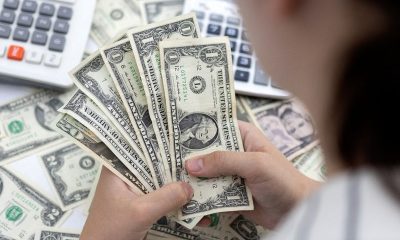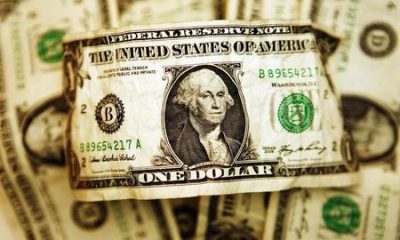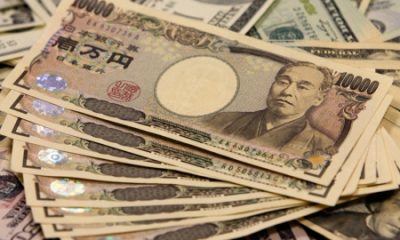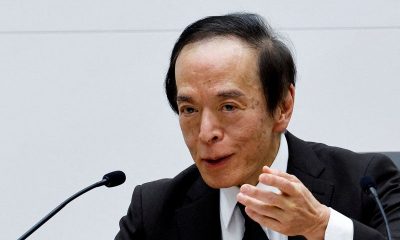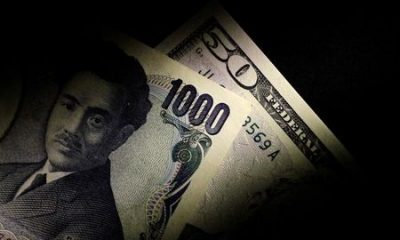Forex
Dollar sags after mixed US growth and inflation report, except against yen

By Alden Bentley and Gertrude Chavez-Dreyfuss
NEW YORK (Reuters) -The U.S. dollar fell on Thursday, except against the yen, vacillating after data showed unexpected slowing in economic growth and an unwelcome inflation acceleration, potentially tying the Federal Reserve’s hands on a pivot to easier interest rates.
While the dollar was hardly shaken against the beleaguered yen, it otherwise only popped briefly after the Commerce Department reported that U.S. gross domestic product grew at a 1.6% annualized rate in the January-March period, slower than the 2.4% rate expected by economists polled by Reuters.
The report also showed that underlying inflation as measured by the core personal consumption expenditures (PCE) price index rose 3.7% in the first quarter, eclipsing forecasts for a 3.4% rise.
The inflation surprise puts an even greater-than-usual focus on the release on Friday of PCE price index data for March. The PCE index, and core PCE index factoring out food and energy prices are among the Fed’s most important gauges of price behavior. Inflation remains stubbornly above the U.S. central bank’s 2% inflation target.
“The market reaction to the (GDP) data tells all you need to know about what investors are focused on and it’s mostly inflation and not growth,” said Boris Kovacevic, global market strategist at Convera in Vienna, Austria.
“The print on the 3.7% PCE does suggest that tomorrow’s PCE number will be higher.”
The yen, meanwhile, hit a fresh 34-year low versus the dollar and a 16-year low against the euro on Thursday as investors expect a Bank of Japan (BOJ) policy meeting that ends on Friday to not be hawkish enough to support the Japanese currency.
remove ads
.
The , a measure of the U.S. currency’s value against six rivals, reversed a small overnight loss after the data caused benchmark Treasury yields to rise, topping at 106.00. It was last at 105.60, off 0.21%.
Conversely, the greenback fell as low as 155.31 yen after the GDP data, but quickly reversed to stand 0.19% higher at 155.63.
It peaked at a 34-year high of 155.75 yen, while the euro/yen pairing surged to 167.025, a 16-year peak.
Investors guessed the dollar/yen 155 level would be a line in the sand for Japanese authorities, above which the BOJ could intervene to shore up the currency. But it’s a moving target and the market has been on high alert for such central bank action since the yen fell below 152 per dollar about two weeks ago.
“I think that Japanese officials have been very clear that they are not really looking at a particular level,” said Marc Chandler chief market strategist, at Bannockburn Global Forex in New York.
“We should expect a hawkish hold from the BOJ where they hold policy and they talk about how the weakness of the yen could contribute to inflation and which they’d respond to.”
The euro went up 0.26% to $1.0725. Sterling strengthened 0.35% to $1.2504.
Following the GDP data, the U.S. rate futures market was pricing in a 58% chance of a Fed rate cut in September, down from 70% late on Wednesday, according to CME Group’s (NASDAQ:) FedWatch tool.
Rate futures traders on Thursday were factoring in a 68% chance that the Fed’s first rate cut since 2020 could happen at its meeting in November.
remove ads
.
“The inflation figures … potentially even point to the need for a further tightening,” said Stuart Cole, chief macro economist, at Equiti Capital in London. “We know that returning CPI (consumer price index) to target is the Fed’s main objective and therefore, on balance, today’s figure probably pushes an interest rate cut further down the road.”
In cryptocurrencies, bitcoin gained 0.80% at $64,492.00. rose 0.94% at $3158.95.
Forex
Sterling slips as BoE holds rates; hawkish BOJ policymakers pause yen slide
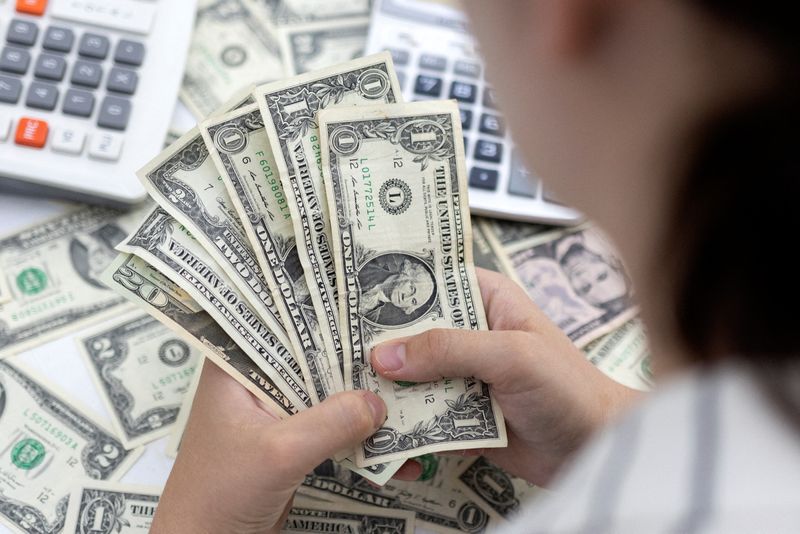
By Joice Alves
LONDON (Reuters) -The pound slipped on Thursday after the Bank of England paved the way for an interest rate reduction as a second official backed a cut, while hawkish opinions from Bank of Japan members helped slow the yen’s fall.
The rose as traders started to focus on U.S. inflation data due next week and its implications for Federal Reserve policy.
The BoE held its benchmark interest rate at 5.25%, as expected, but a second official on the Monetary Policy Committee backed a cut, in what was seen as another step towards the bank lowering interest rates.
BoE officials voted 7-2 to keep rates at a 16-year high. Deputy Governor Dave Ramsden joined Swati Dhingra in voting for a cut to 5%.
Sterling later steadied on the day at $1.2505, recovering losses after hitting a two-week low immediately after the BoE’s policy decision.
Investors have been watching for signs to firm their expectations on when cuts could come.
“It’s likely that we will need to cut bank rates over the coming quarters and make monetary policy somewhat less restrictive over the forecast period, possibly more so than currently priced into market rates,” BoE Governor Andrew Bailey told journalists.
He added that more data will be available before a BoE decision for the June meeting is made.
Money markets see a 75% chance of a first cut in August, with the odds of such a move coming in June at a 45% chance.
remove ads
.
“Sterling is recovering some of the fall made on the back of the BoE’s policy statement,” said Jane Foley, Head of FX Strategy at Rabobank.
“The dovish overtones will spark more optimism that the Bank may be ready to cut rates in June, though we expect that services sector inflation will result in a steady policy outcome until August”.
Elsewhere, the dollar has been slowly inching up against the Japanese yen after it fell 3.4% last week, its biggest weekly percentage drop since early December 2022.
The yen was flat on the day at 155.62 per dollar, with the Japanese currency briefly finding some support in the BOJ’s summary of opinions released on Thursday. The summary showed board members were overwhelmingly hawkish at their April policy meeting, with many calling for steady interest rate hikes.
The “BOJ appears to be hinting at the next rate hike, which could come in June or July as final results of wage negotiations come out,” said Charu Chanana, head of currency strategy at Saxo.
In the U.S., last week’s Fed policy meeting and weaker than forecast U.S. jobs growth have markets increasing bets for two rate cuts this year. But a chasm remains between Japan’s ultra-low yields and those in the United States.
Japan’s top currency diplomat Masato Kanda on Thursday reiterated a warning that Tokyo is ready to take action in the currency market.
Market players suspect Tokyo spent some $60 billion last week to stem the yen’s slide after it hit its weakest in 34-years against the dollar around 160 yen.
remove ads
.
The dollar index, which measures the greenback against a basket of currencies including the yen and the euro, edged 0.04% lower to 105.46, having touched a one-week high earlier.
Traders will be closely watching April U.S. producer price index (PPI) and the consumer price index (CPI) out next week for signs that inflation has resumed its downward trend toward the Fed’s 2% target rate.
China’s was about flat on the day at 7.2278, as data revealed China’s exports and imports returned to growth in April after contracting in the previous month.
That could mean a potential delay for rate cuts some analysts believe China would need to make to meet its 2024 GDP goal.
Forex
Dollar edges higher, helped by hawkish Fed speakers ; Sterling slips ahead of BOE

Investing.com – The U.S. dollar edged higher Thursday, trading in a tight range ahead of next week’s all-important U.S. inflation data, while the pound slipped ahead of the Bank of England’s policy-setting meeting.
At 04:35 ET (08:35 GMT), the Dollar Index, which tracks the greenback against a basket of six other currencies, traded 0.2% higher at 105.605, rebounding after last week’s one-month low.
Tight trading range ahead of US CPI
The dollar has steadied this week, after last week’s sharp losses, after a number of Fed officials have pushed back against the idea that rate cuts are a certainty this year.
Minneapolis Fed boss suggested on Tuesday that stubborn inflation and a robust economy could persuade the U.S. central bank to keep interest rates unchanged for the rest of this year.
Fed Bank of Boston President continued the theme on Wednesday, saying that the U.S. economy needs to cool to return inflation back to target.
There are more speakers due both Thursday and Friday, as well as weekly data.
However, trading ranges are likely to be limited ahead of next week’s April U.S. and, in particular, the , which traders will watch for signs that inflation has resumed its downward trend toward the Fed’s 2% target rate.
Sterling slips ahead of BOE meeting
In Europe, traded 0.2% lower to 1.2475, ahead of the latest rate-setting meeting.
The U.K. central bank is not expected to move interest rates later Thursday, and thus the big question is whether the officials signal that a cut will come in June, when the European Central Bank has already signalled it will.
remove ads
.
A cut is fully priced for August and last week sterling short positions rose to their largest since January 2023, so sterling could be volatile if post-meeting guidance doesn’t match up to the market’s expectations.
In Europe, traded 0.1% lower to 1.0732, trading largely unchanged given a light data calendar.
“It’s hard to see EUR/USD breaking far from 1.0750, unless the BoE is demonstrably dovish and GBP/USD drags EUR/USD lower with it,” said ana;ysts at ING, in a note.
Yen drifts lower despite rate hike talk
In Asia, rose 0.3% to 155.87, with the yen remaining weak despite hawkish opinions from Bank of Japan’s members.
The BOJ’s summary of opinions released earlier Thursday showed board members were overwhelmingly hawkish at their April policy meeting with many calling for steady interest rate hikes.
BOJ Governor Kazuo Ueda also warned that any inflationary pressures arising from weakness in the yen could invite monetary tightening by the central bank.
That said, the yen has still resumed its decline even after a couple bouts of suspected intervention.
rose 0.1% to 7.2260, with the yuan struggling to maintain earlier gains after data showed Chinese grew substantially more than expected in April, signaling some strength in domestic demand.
Forex
Asia FX muted, Japanese yen pauses losses after BOJ warning
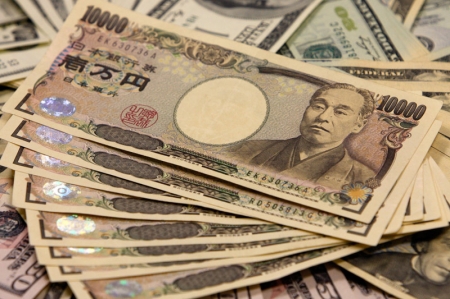
Investing.com– Most Asian currencies moved in a flat-to-low range on Thursday as markets sought more cues on U.S. interest rates from Federal Reserve officials and upcoming inflation data.
The Japanese yen saw some resilience, with the pair pausing its recent decline after somewhat hawkish comments from the Bank of Japan. Traders were also on guard over any more intervention in currency markets by the government.
Broader Asian currencies were muted as the dollar rebounded from recent losses this week, as a string of Fed officials warned that sticky inflation was likely to keep interest rates high for longer.
Japanese yen pauses losses, USDJPY hovers above 155
The Japanese yen’s USDJPY pair- which is inversely representative of strength in the yen- hovered around the mid-155s on Thursday, pausing its recent run of losses.
The pause came after BOJ Governor Kazuo Ueda warned that any inflationary pressures arising from weakness in the yen could invite monetary tightening by the central bank- changing his stance after stating last month that the yen’s recent declines did not directly impact inflation.
Ueda’s comments were sufficient in stemming losses in the yen, which was weakening even after the Japanese government seemingly intervened in currency markets last week.
Still, data for March spurred doubts over just how much headroom the BOJ actually had to tighten policy.
Chinese yuan trims losses as imports surge
The Chinese yuan’s trimmed some intraday gains after data showed Chinese grew substantially more than expected in April, signaling some strength in domestic demand.
remove ads
.
While also beat expectations, the spike in imports saw China’s grow less than expected. Still, the trade balance grew from a four-month low hit in the prior month.
While increased imports usually bode poorly for currencies, the yuan was supported by optimism over a potential economic recovery in China, which was supporting local consumption.
Dollar steadies with Fed speakers, inflation data on tap
Broader Asian currencies were muted, as the and steadied after a strong rebound this week.
Focus was squarely on more Fed speakers on Thursday and Friday, as well as key data due next week.
Doubts over U.S. interest rates kept most Asian currencies trading sideways on Thursday. The Australian dollar’s pair rose less than 0.1%, while the Singapore dollar’s and the South Korean won’s pairs were flat.
The Indian rupee’s pair moved little, but remained in sight of record highs hit in late-April.

 Forex2 years ago
Forex2 years agoForex Today: the dollar is gaining strength amid gloomy sentiment at the start of the Fed’s week

 Forex2 years ago
Forex2 years agoHow is the Australian dollar doing today?

 Forex1 year ago
Forex1 year agoUnbiased review of Pocket Option broker

 Forex2 years ago
Forex2 years agoDollar to pound sterling exchange rate today: Pound plummeted to its lowest since 1985

 Cryptocurrency2 years ago
Cryptocurrency2 years agoWhat happened in the crypto market – current events today

 World2 years ago
World2 years agoWhy are modern video games an art form?

 Stock Markets2 years ago
Stock Markets2 years agoMorgan Stanley: bear market rally to continue

 Economy2 years ago
Economy2 years agoCrude oil tankers double in price due to EU anti-Russian sanctions

